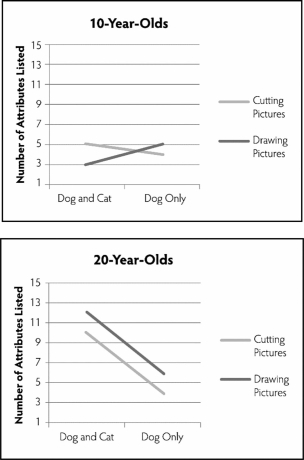(The first paragraph is repeated from earlier.The second paragraph is specific to the new set of questions.The first paragraph is necessary to set up the original study. )
Dr.Elder was interested in the way people recognize objects as members of categories.For example,what makes us recognize a dog as being a dog and not a cat? More specifically,he was curious as to whether people think about categories in a more complex way if they contemplate an "opposite" category first.For example,does a person think more differently about the category of "southern" if they are also thinking about the category of "northern"? He is also curious as to whether people categorize differently if they are exposed to category members compared with generating category members.Dr.Elder has four groups of participants (with 30 people in each group) .In Group A,participants were told to cut out pictures of dogs and cats from magazines.In Group B,participants were told to cut out pictures of just dogs from magazines.In Group C,participants were told to draw pictures of cats and dogs.In Group D,participants were told to draw pictures of just dogs.After doing this for 30 minutes,participants in all groups were asked to list the attributes that define the "dog" category.Having a higher number of attributes listed was considered to be an indication of thinking about the category in a more complex way.
Dr.Elder also is curious as to whether categorization happens similarly for children as it does for adults.As such,he recruits a group of 10-year-olds and a group of 20-year-olds to participate in the study.The results are below.

-Based on the graphs above,why should Dr.Elder conclude that there is a three-way interaction?
A) There is a two-way interaction for 10-year-olds but not for 20-year-olds.
B) There is a two-way interaction for 20-year-olds but not for 10-year-olds.
C) There is a two-way interaction for 10-year-olds that is different from the two-way interaction for 20-year-olds.
D) There is no two-way interaction for either 10-year-olds or 20-year-olds.
Correct Answer:
Verified
Q7: Which of the following CANNOT be said
Q10:
Dr.Elder was interested in the way people
Q11:
(The first paragraph is repeated from earlier.The
Q13:
(The first paragraph is repeated from earlier.The
Q15:
(The first paragraph is repeated from earlier.The
Q16:
Dr.Elder was interested in the way people
Q17:
Dr.Elder was interested in the way people
Q18:
Dr.Elder was interested in the way people
Q19: In the case of a factorial design,
Q19: The number of main effects that need
Unlock this Answer For Free Now!
View this answer and more for free by performing one of the following actions

Scan the QR code to install the App and get 2 free unlocks

Unlock quizzes for free by uploading documents